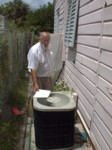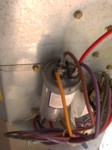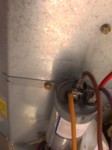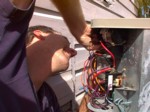How I Fixed My Central Air Conditioning Without Injury Or Embarrasment
The Symptoms
The symptoms were pretty basic: the house was hot. So I went outside to
look at the air conditioner. It was night, so I took a flashlight. The
outside unit wasn't running, even though there was air blowing inside. I
found an electric box for the air conditioner, lifted the cover, and found
a blown breaker. So I reset it, and instantly got a big flash from somewhere
inside the air conditioner and the breaker popped again. Okay, that's it
for tonight. We got by with a fan inside.
Investigate
The next day I went out and looked through the cover and reset the breaker
again. This time I could see the flash at the base of the compressor, where
the wires went in. So I took off the air conditioner cover and looked inside.
I took the cover off where the wires entered the compressor, and it was a
little smokey. This must have something to do with the problem.
Since I don't know anything about house air conditioners, I went the the
same place I always go -- the internet. I found
Scott Meenen's excellent web site,
which gave me a lot of info. I suspected the compressor, so I followed
Scott's info for testing it. My dad came by while I was doing it and helped
out.

I had looked up compressors on Grainger
and found a couple that were close to mine. The lowest price was $309.
I called a couple places locally, and found that if I wasn't in the business
nobody would sell me a compressor!
I wanted to measure the resistance between the compressor power terminals
and the compressor case. I got 4 ohms and 5 ohms. That seemed low, but I
wasn't sure if it was low enough. So I emailed Scott, but got no reponse
by that afternoon. Scott's page said he could be reached by AOL Instance
Messenger, so I found an IM client called
Trillian and installed it and got an AOL IM login and found that Scott
was on. So I sent him a message, but got no response. That evening, though,
he answered, and asked for a phone number, and called me long distance! We
talked for a while, and Scott answered all my questions. He couldn't say if
the compressor was bad, but he suggested that I pull off the start wire and
try running it. If it hummed, that meant the start circuit was bad. The
next day I tried it. Before I did, though I took a couple pictures so I
could be sure to put it back the same way. I found out later that the object
in the pictures is a combo capacitor for the fan and the compressor.
That afternoon my dad had lent me a spare window unit from one of his rentals,
so that kept us cool for the night.


The compressor hummed, which meant that it was okay! So I went inside and
looked up how AC motors work on the internet. I had taken a circuits class
as part of a basic engineering, but that was a long time ago, and all I
remembered was there was a way to offset one of the phases from the other
and keep running that around the outside of the motor to push the rotor and
make it spin. A quick refresher told me that the offset was done with a
capacitor, and that an even bigger capacitor could be used temporarily to
generate more torque when the motor first started up. So I decided that the
start capacitor was bad, and that I would replace it with a hard start kit.
My First Mistake
I looked through the phone book and found an AC service company close to my
house, Palm Beach Air. I called
them, and sure enough they had a hard-start kit. I was over in five minutes.
They were very nice, and the owner took time to explain to me how to put it
in.
I'm not really sure why I jumped to the conclusion that a hard-start kit was
the right thing to do. I guess because it has a capacitor in it, and I
suspected a capacitor? I didn't really have an understanding of what I was
doing. So I put the kit in without too much trouble. I did have to unmount
the cap and relay from the supplied bracked, and mount each individually
in the air conditioner. I spent a long time studying the directions and the
wiring diagram in the air conditioner, and was pretty sure I had it hooked
up right. I hit the breaker, and I still got the flash and popped the breaker.
Logical Thinking
Okay, that didn't work. What about seeing what did work? My multimeter
does have a capacitor testing mode on it, so I decided to test the capacitor.
By this time I had figured out that this capacitor with three terminals was
actually a combination capacitor, with a 30 µ terminal for the compressor
(C), and a 5 µ terminal for the fan (F), and a common power terminal
(HERM). I still wasn't clear whether it was a run or a start capacitor,
though. Anyway, I put the meter on it, and the fan side read 5 µ, and
the compressor side read 0. Okay, then. So I went back to Palm Beach Air.
There was someone different in the office, but she was very helpful, calling
the service guys to make sure she got me the right part. Eventually one of
the guys working there went to get the capacitor while I waited. The one I
got was oval rather than round, and was a 35/5, but they said it would work
fine. I got it mounted and wired without much trouble, hit the switch, and
vroom, the compressor fired right up. Whee. All fixed.
You can see me mounting the hard-start kit here. The new capacitor is
horizontally mounted at the top. I made sure to read the directions.


Not Yet
I went off to play frisbee, and when I got back at 11:30pm I checked on the
unit. The fan was making a heck of a racket, and the case was really
vibrating. If I put my hands on top of the case it would dampen the vibration,
but as soon as I took them off it started right up. It was so bad the freon
lines into the house were buzzing against the wall. So I turned it off and
went inside and fired up the window unit for the night.
My Second Mistake
The next day my friend Rob stopped by, and was interested in the problem. I
pulled the cover off the unit again. We looked at the fan, and Rob pointed
out that it seemed to be missing a balance weight. We couldn't find it
anywhere near the AC unit. I put the fan and motor on the bench, and we
found it seemed a little better balance when we removed a second weight. I
put the fan back in, wired it up and hit the breaker. It fired up and ran
much quieter. Success!
Except when I checked on it a couple hours later, there was only an ominous
hum, and a slight smokey smell. I killed the power and pulled the fan out.
It was too hot to touch, and there was liquid coming out of it. A check of
the wiring showed that in my haste I had reversed two wires. Darn. It was
time for lunch, anyway. On the way back from lunch we stopped by an
applicance parts place and got a replacement motor, and also a new fan and
hub. The new motor had a slightly different bolt pattern, but there was a
second set of holes on the air conditioner case. I did have to use a grinder
to shorted the studs on the top of the motor, otherwise the acorn nuts the
original motor used would not have worked. Plus there would have been four
sharp studs sticking up in the air. I also trimmed the studs on the bottom
of the motor some (foreshadowing music goes here). The new fan and hub
went on fine, and we put installed the new motor and started wiring it.
Not Really A Mistake
The old motor had three lines (start, run, common) while the new motor had
four lines (two for the capacitor, two for power). I opted to use the
5 µ capacitor that came with the motor, and left the one in the combo
unit unused. We ran the two power lines to the two sides of the relay,
and hit the breaker. The compressor started up, but the fan just jerked a
little. Hmmm.
Took the cover off, checked all the wiring, put it back, tried it again,
same results. Much head-scratching and review of how an AC motor works.
Another disassembly, check to be sure the supply lines are both bringing
in 120 volts. They are. Reassemble, try it again, still not working.
Completely perplexed, we decide to extend the ground from the fan motor all
the way to the neutral from the supply line, even though we know it won't
help. But when we reassembled it this time, we left the fan cover loose, and
we could see the fan kick a little, and realized that it was being held back
by the compressor! The longer motor shaft meant that the fan was contacting
the compressor!
So we pull it off one more time, and move the fan further up on the shaft so
it will clear the compressor. Reassemble, hit the power, and get a loud
scraping as the fan rubs on part of the freon tubing. We can't move the
fan higher up, because the mounting studs on the bottom of the motor are in
the way. Time to get the grinder and cut them off flush. Reassemble, hit
the power, and everything works! And boy is that fan quiet!
Finish The Job
It was time for dinner. A couple hours after dinner I noticed the house
wasn't that cool. I checked outside, and found that the breaker had tripped.
I knew that was a bad sign, but I reset it. When I checked it 30 minutes
later it had tripped again. So I turned the AC off, and turned on the window
unit for the night.
A friend suggested changing the circuit breaker (said it happened to him).
I went out and reset the breaker, to see how long it took to pop. I waited
out there for 20 minutes, and it didn't go. The AC ran all day long, and
I was beginning to think I had gotten away with it, when I noticed around
4pm that it had tripped. So
I pulled it out and took it to Home Depot, but they didn't have that
style. The next day I went by the local big electrical supply place and
they didn't have it either. In fact, they called my breaker an antique :).
It's a Wadsworth.
So they sold me a new enclosure and a single-pole 60 amp breaker for $20.
We put it in, and it hasn't popped so far.
I'm still hanging on the window unit for a couple more days, but I think my AC
just might be fixed.
Wait, one more update. I emailed Scott to thank him and tell him about this
page, and he emailed me back saying I should not be using a 60 amp breaker.
Well, I thought about it, and he's right. I was thinking that somehow a
two-pole breaker at 30 amps is equal to a single-pole breaker at 60 amps,
but it's not. I don't know what that guy at the electrical supply place was
thinking. Plus when I went out to check it, I saw that what I had was not a
breaker, but simply a switch! There is no over-current capability on it.
So I yanked it out and headed off to Home Depot, where I was able to buy a
shiny new double-pole 30 amp breaker that snapped right into my new
enclosure. I didn't even bother going back to the electrical supply place,
I'll just eat the cost of the switch. It's still cool in here, though.




